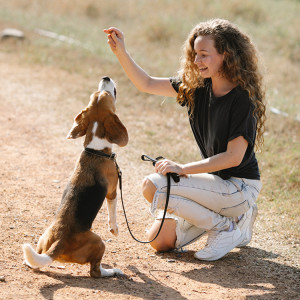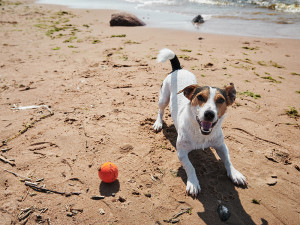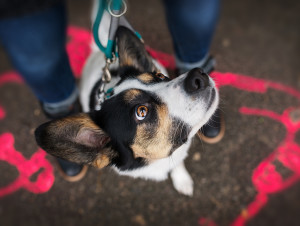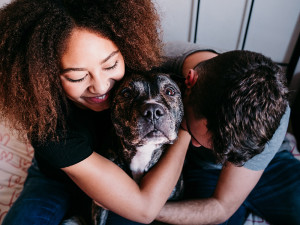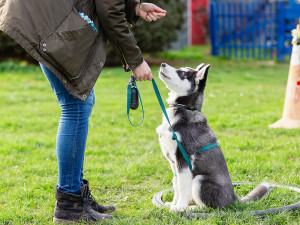Is Your Dog a People Pleaser?
Yes — and no. Here’s why positive-reinforcement training matters.
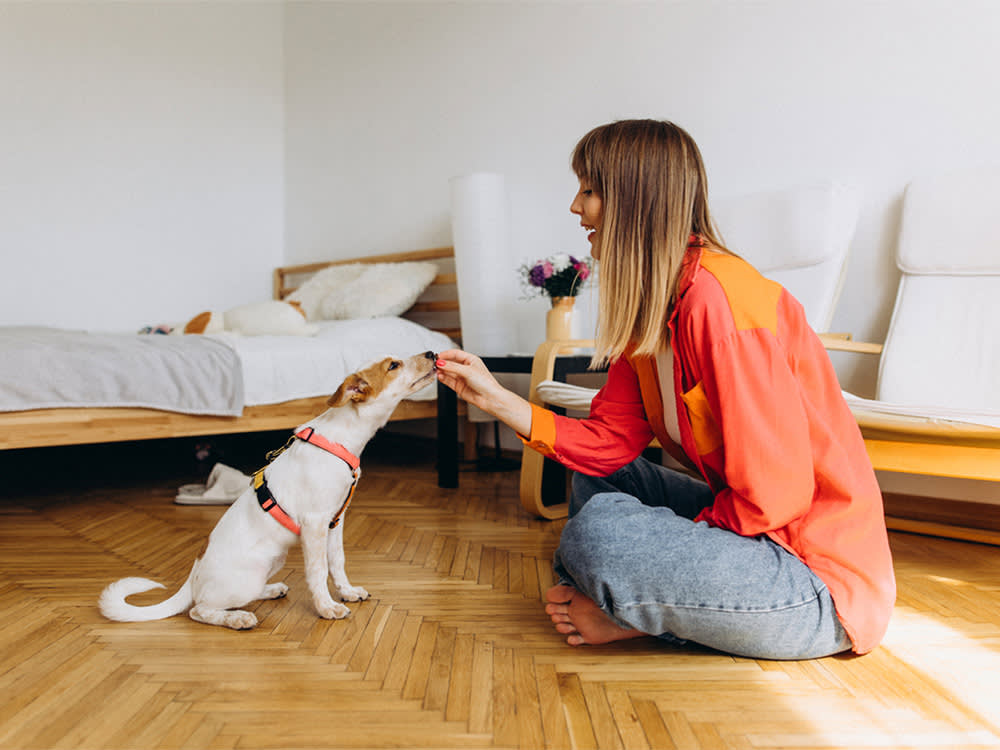
share article

Your pet wants you to read our newsletter. (Then give them a treat.)
Your pup is your best friend, and they’s follow you anywhere — even, sometimes, into the bathroom (OK, a little too much love). And they want to make you happy. This doesn’t mean that’s all they want in life, though. People like to think that their dogs have naturally evolved into being little people-pleasers, but like all living creatures, they have their own desires and agendas. This misunderstanding is pretty common, and it really affects how dog parents approach training and getting to know their dogs.
For example, a nervous dog who can’t face strangers, dog parks, traffic won’t get over those things just to make you happy. A positive-reinforcement dog trainer might approach your dog’s anxiety by giving them treats every time they’re around a trigger, distracting them from the problem, and making it a fun moment instead. Car drives by? Treat! Strangers approach? Treat! Twenty preschoolers holding hands skipping by? Treat! Treat! Treat!
There will always be Debbie Downers who contradict this process by saying, “You’re spoiling her,” or “My dog sits because he wants to please us. You should make your dog respect you.” Or “You’re bribing her.”
Is this really a valid way to see dogs’ motivations? Are dogs born with a desire to please? And why, if thousands and thousands of animals — chickens, goats, sea lions ,and parrots and so on — have been professionally trained using food as motivation, is there such a stigma about using food to train dogs? Here’s what professional dog trainers and dog psychologists say about the canine disposition.
Does domestication make a dog behave?
There’s no scientific research to prove this either way. Dog cognition is a growing area of study today, so down the road, we might have a better sense of what exactly is going on inside our dogs’ little noggins. As of now, we don’t have any real idea.
“I would accept the fact that because of the close relationship that dogs have had with humans for so long, they maybe do have this predisposition to want to please,” says Marc Bekoff, author and professor emeritus of ecology and evolutionary biology at the University of Colorado, Boulder. “But then when you consider that around 75 percent of all dogs on the planet are feral…I’ve met lots of feral dogs who don’t really care about me. They want to avoid me more than anything.”
Are you making up what your dog is thinking?
There is a tendency in most dog parents to anthropomorphize their pets, which can lead to a lot of misunderstanding. Just as they do with other humans, people have a tendency to ascribe motives that don’t necessarily exist to their dogs.
“[People] project all sorts of things on all sorts of social relationships, ranging from dogs to other humans,” Bekoff says. “You go to dog parks and [you’ll hear] dogs characterized in one way: playful, standoffish, maybe a little aggressive. It’s incredible how different people watch the same dog and have a completely different personality profile for the dog.”
Do dogs experience guilt or remorse?
Alexandra Horowitz is a professor of psychology and canine cognition at Barnard College at Columbia University, and she led a study in 2009 to test this. She wanted to see if people who claimed their dogs were showing that well-known “guilty look” when they came home to a torn-up couch or a pile of poo on the antique rug were actually reading the dog correctly.
In the experiment, participants told their dogs not to eat a treat the pup wanted and then left the room. When they returned, the researchers would tell the dog’s parent whether or not the dog ate the treat. But the researchers were not always truthful. In some cases, the dog would leave the treat alone but the parent would be told that they ate it, or vice versa. Thus, sometimes dogs who did what they were told were scolded and others who disobeyed by eating the treat were not.
It turns out that the behavior dog parents were sure represented guilt — some combination of avoiding eye contact, rolling over, tail tucking, tongue flicking, pressing their ears back and/or skulking away — was tied to the parent’s tone of voice and demeanor. The look, therefore, more likely represented the dog’s anticipation of punishment or attempting to evade it than feeling guilt.
Why is it a problem to assign feelings to dogs?
Thinking your dog understands and feels about situations in the same way you do is actually bad for the dog.
“This misattribution could be harmful to dogs if their owners have expectations that the dogs do understand rules, correct behavior, and so forth, and believe that dogs either willfully or neglectfully violate these rules,” Horowitz and Julie Hecht write in a chapter they co-authored for the book Domestic Dog Cognition and Behavior: The Scientific Study of Canis familiaris.
Jean Donaldson, founder of the Academy for Dog Trainersopens in a new tab, has been the voice of opposition to the “desire to please” notion for more than two decades for just this reason. “Trainers who make claims about dogs working ‘to please’ or strictly for praise,” she writes in her book Culture Clash: A Revolutionary New Way of Understanding the Relationship Between Humans and Domestic Dogs. “Seems oblivious to the main motivator they employ: pain.”
Rather than being given food or toys or something else they really love to reinforce good behavior, dogs are punished for bad behavior.
“We expect dogs to do things without reward, that they should know that sitting is what I want them to do, or they should know this or that,” says Jill Sackman, veterinary behaviorist and member of the American Veterinary Society of Animal Behavioropens in a new tab. “I don’t think we [reward] enough with human beings either. We live in a culture where it’s like, ‘I’m gonna point out your negative’ instead of capturing you doing something really great and continuing to reward that.”
What are some of the worst training techniques to come out of this POV?
Twenty years after the first publication of Culture Clash, there is still evidence of trainers using pain to punish dogs for being “disobedient” rather than teaching them what to do and reinforcing that behavior.
Nicky Wilke turned to trainers last year for help with her 90-pound Husky mix, Charlie, who would pull her to the ground when he darted after another dog. Wilke was horrified by the methods they recommended. She was expressly told by multiple trainers not to use food because Charlie would only behave for the “bribe” and not because he respected her.
“Everyone was telling me I had to be more firm with Charlie,” Wilke says.
And by “be more firm,” they meant that she should use some incredibly cruel techniques to punish Charlie when he didn’t do what they wanted: shock him with electricity from a collar around his neck. Wrap his leash around his belly near his genital area so that it would rub when he pulled. Squeeze a pressure point right above his back leg if he reacted to another dog.
“If we say something really clear like ‘come’ or ‘sit,’ and on occasion we witness the dog not doing it, it’s almost impossible for people to interpret anything other than, ‘He knows what to do, I’ve seen him do it, and now that he’s not doing it, it’s because of some sort of power struggle,’” Donaldson says in a phone interview. “And as soon as you get into ‘power struggle,’ then we’re down the rabbit hole.”
What are some alternative approaches to support a dog's real nature?
Wilke persevered and found Renée Erdman, a positive-reinforcement trainer and graduate of the Academy for Dog Trainersopens in a new tab. Erdman has helped Wilke teach Charlie how to walk politely on leash and how to behave around other dogs.
“She saved our lives,” Wilke says. “I used to have anxiety taking Charlie out for a walk. I went from not being able to walk past a dog to introducing Charlie to dog parks and playing with seven dogs at the same time.”
Erdman’s magic trick? Food.
“Once I started getting into different treats — really tasty treats — it was like, okay, now he’s paying attention to me. Now he’s interested in playing the games and learning,” Wilke says. “It was an amazing feeling to finally have control of the situation, and I feel more connected and bonded to my animal because he’s actually looking to me. He’s wanting to learn.”
You may continue to be questioned or judged for using food as a reward with your dog when they don’t eat dog poop after you tell them “leave it.” Remember, though, your dog is not working you for food. They don‘t love you any less because they know they’ll get a jackpot of treats. In fact, it’s quite the opposite. You’re just creating positive associations of being with and listening to you.
“I think that to play that dichotomy of food versus true love is ridiculous,” Bekoff adds. “It’s just not supported by any research at all.”

Tracy Krulik, CTC, CSAT
Tracy Krulik, CTC, CSAT, is a Northern Virginia-based certified canine separation anxiety trainer and honors graduate of Jean Donaldson’s prestigious Academy for Dog Trainersopens in a new tab. Krulik is also the founder and managing editor of iSpeakDogopens in a new tab — a website and public awareness campaign to teach dog body language and behavior.
Related articles
![Man hugging his fluffy white dog happily]() opens in a new tab
opens in a new tabChemistry Between People and Dogs Is Real (It’s Science)
How the “love hormone” oxytocin connects us with our pups.
![Dog on leash sitting on a colorful street and looking attentive at their pet parent]() opens in a new tab
opens in a new tabYou — Yes, You — Can Get Your Dog to Pay Attention to You
Here are some simple steps to pry your pup away from that one spot in the yard they’re obsessed with.
![Couple hugs their merle Boxer]() opens in a new tab
opens in a new tabYour Relationship With Your Dog Matters. Here’s How You Can Improve It
Animal behaviorist Dr. Karen B. London on how to strengthen your pet-parent bond.
![illustration of multi-colored dogs]() opens in a new tab
opens in a new tabIs Your Dog Tricky to Train? Here’s Why You Shouldn’t Feel Guilty
It’s important to remember that dogs are individuals, so training isn’t one-size-fits-all.
![Boston terrier being stubborn]() opens in a new tab
opens in a new tabDog Training — DIY or Hire a Pro?
When it’s time to call in reinforcements.
![Woman trains with a young husky on a dog training field]() opens in a new tab
opens in a new tabPro Tips: How to Find a Qualified Dog Trainer
The questions to ask and credentials to look out for to find the right trainer for your dog, according to a pro.
